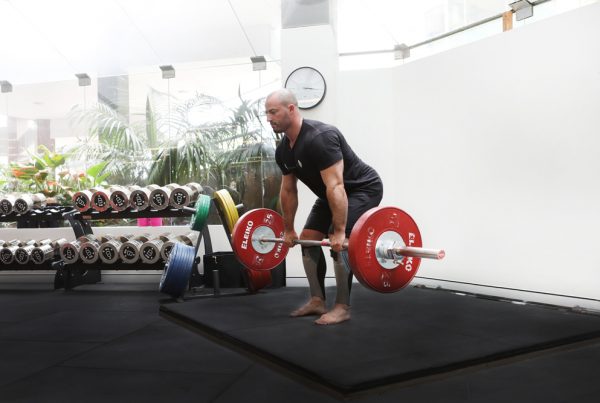PROGRAM INSTRUCTIONS
Below you will find your program. Each exercise has a breakdown of the movement using a written description and an exercise tutorial video for you to follow
First warm up by following the prescribed Warm Up Routine eg. Core Activation Routine below
Once the Warm Up Routine has been completed, it is time to start warming up to your working weight/weight for your first set.
For squats for example start with 10 x body weight squats x 2, then start the loading process. Perform 8 reps on an empty barbell, 5 reps on the next increment, 3 on the next and single reps for every set until you reach your working weight, which you will then perform the prescribed amount of reps and sets. A very general way of calculating your increment increases is to calculate 10% of your working weight and that number is your weight increment increases.
Once you have warmed up to and completed your first set, your body should be warm and your nervous system primed, so there is no need to warm up again using the above process for each exercise, however we do recommend performing the new exercise at least once before your first set of that exercise to familiarise yourself with the movement and perfect your technique.
Please note your warm up sets do not count towards your total amount of working sets.
Perform all ‘A’ exercises back to back for all reps and sets, and then move on to ‘B’ exercises eg. A1 Bench Press x 5 reps, rest 3 minutes, then go to A2 – Row x 5 reps, rest 3 minutes, then back to A1 again until all the prescribed reps and sets of ‘A’ exercises are completed, then move to ‘B’ exercises and so on. Continue to follow the sequence of letters
Let’s get strong!
EXERCISE
A COMPETITION BENCH PRESS
-
Lay down on the bench with eye level slightly behind the barbell
-
Feet back standing on the balls of the feet with the heels off the ground
-
Push the heels downwards throughout the entire movement from start to finish
-
Sole of the foot roughly 45 degrees
-
Set up shoulder blades (scapula) so they are back and down towards your back pockets throughout the whole set
-
Grip the bar at described grip width
-
Lower the bar towards your chest under control – imagine pulling the bar apart
-
Lightly touch the bar on the chest and push the weight straight back up to the start position
WHAT WEIGHT DO I USE?
On your 2 sets of Competition Bench Press, work up to a weight on set 1 with an RPE of 7, and then increase the weight and end with set 2 with an RPE of 8. The weight of set 2 will be the weight you input for your Load Calculator in Program 1.
RPE stands for Rate of Perceived Exertion and is a system used to grade your working intensity. The level of intensity is given a score between 1-10 where 1 is almost effortless and 10 is the maximum possible effort. Usually an RPE of 10 should be reserved for competition so in our training it is most effective to be working between RPE 7-9 as this is generally challenging enough to elicit a positive adaptation yet not quite working to our absolute limit which can be a high risk of technical breakdown and therefore a high risk of injury.
During the testing week it is important test our ability with an intensity high enough to be able to determine the appropriate loads for the remainder of the program. In the main exercises I have prescribed multiple sets to prepare the body for the final set of 5 reps at an RPE of 8 to help best determine the perfect numbers for each session of the 16 week peaking program.
SETS
2
REPS
5
REST
5 MIN
EXERCISE
B1 SEATED DUMBBELL SHOULDER PRESS
- Set up in an adjustable bench in an upright position
- Start with dumbbells above your shoulders in a full stretch position
- Hold the dumbbells in a neutral grip – palms facing each other
- Press the dumbbells up, keeping the shoulders blades back and down
SETS
3
REPS
8
REST
2-3 MIN
RPE
7
EXERCISE
B2 LAT PULL DOWN
-
Grab the lat pull down bar slightly wider than shoulder width, with a pronated (overhand) grip
-
Set up pad over thighs so it locks you comfortably in place for the set
-
Leaning back only a few degrees, pull the bar towards your chest focussing on pulling the shoulder blades (scapula) back and down towards the back pockets
-
Control the weight back to the start point in a full stretch position
SETS
3
REPS
8
REST
2-3 MIN
RPE
7
EXERCISE
C ROPE FACE PULL - TO TOP OF HEAD
- Hold rope handles in each hand
- Point index finger in the same direction of rope
- Pull rope handles apart to the same height as your mouth
- Keeping elbows high and flared out to the side
- Lower weight under control to full stretch position
- Repeat movement
SETS
2
REPS
12
REST
90 SEC
RPE
7
A1 | COMPETITION BENCH PRESS
SETS: 3
REPS: 5
REST: 2-3 MINUTES
WHAT WEIGHT DO I USE?
On your 2 sets of Competition Bench Press, work up to a weight on set 1 with an RPE of 7, and then increase the weight and end with set 2 with an RPE of 8. The weight of set 2 will be the weight you input for your Load Calculator in Program 1.
RPE stands for Rate of Perceived Exertion and is a system used to grade your working intensity. The level of intensity is given a score between 1-10 where 1 is almost effortless and 10 is the maximum possible effort. Usually an RPE of 10 should be reserved for competition so in our training it is most effective to be working between RPE 7-9 as this is generally challenging enough to elicit a positive adaptation yet not quite working to our absolute limit which can be a high risk of technical breakdown and therefore a high risk of injury.
During the testing week it is important test our ability with an intensity high enough to be able to determine the appropriate loads for the remainder of the program. In the main exercises I have prescribed multiple sets to prepare the body for the final set of 5 reps at an RPE of 8 to help best determine the perfect numbers for each session of the 16 week peaking program.
HOW TO
-
Lay down on the bench with eye level slightly behind the barbell
-
Feet back standing on the balls of the feet with the heels off the ground
-
Push the heels downwards throughout the entire movement from start to finish
-
Sole of the foot roughly 45 degrees
-
Set up shoulder blades (scapula) so they are back and down towards your back pockets throughout the whole set
-
Grip the bar at described grip width
-
Lower the bar towards your chest under control – imagine pulling the bar apart
-
Lightly touch the bar on the chest and push the weight straight back up to the start position
B1 | SEATED DUMBBELL SHOULDER PRESS
SETS: 3
REPS: 8
REST: 2-3 MINUTES
RPE: 7
HOW TO
- Set up in an adjustable bench in an upright position
- Start with dumbbells above your shoulders in a full stretch position
- Hold the dumbbells in a neutral grip – palms facing each other
- Press the dumbbells up, keeping the shoulders blades back and down
B2 | LAT PULL DOWN
SETS: 3
REPS: 8
REST: 2-3 MINUTES
RPE: 7
HOW TO
- Grab the lat pull down bar slightly wider than shoulder width, with a pronated (overhand) grip
- Set up pad over thighs so it locks you comfortably in place for the set
- Leaning back only a few degrees, pull the bar towards your chest focussing on pulling the shoulder blades (scapula) back and down towards the back pockets
- Control the weight back to the start point in a full stretch position
C | ROPE FACE PULL – TO TOP OF HEAD
SETS: 2
REPS: 12
REST: 90 SECONDS
RPE: 7
HOW TO
- Hold rope handles in each hand
- Point index finger in the same direction of rope
- Pull rope handles apart to the same height as your mouth
- Keeping elbows high and flared out to the side
- Lower weight under control to full stretch position
- Repeat movement




